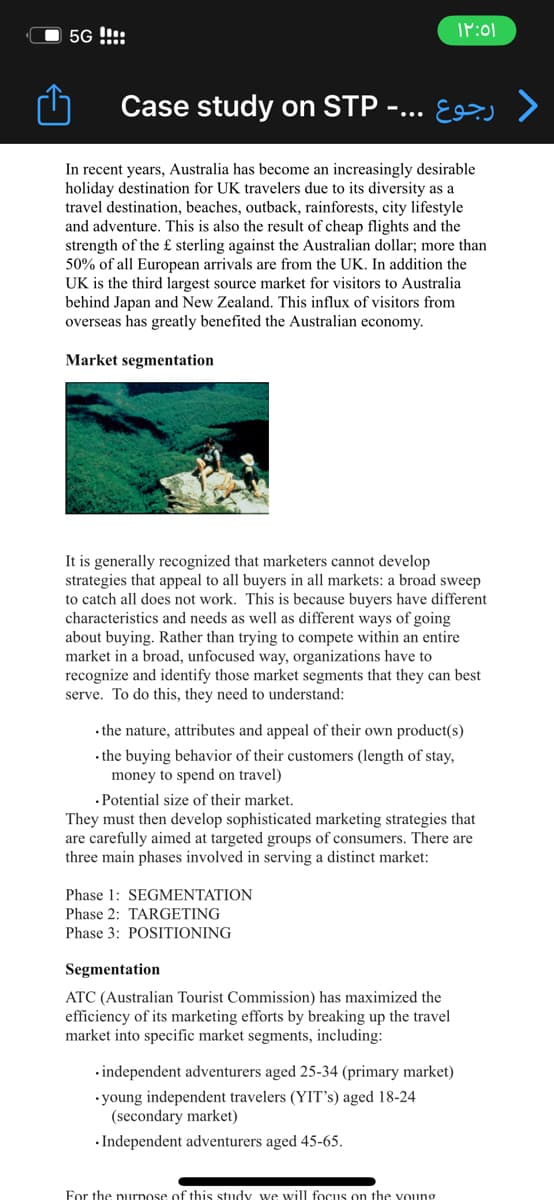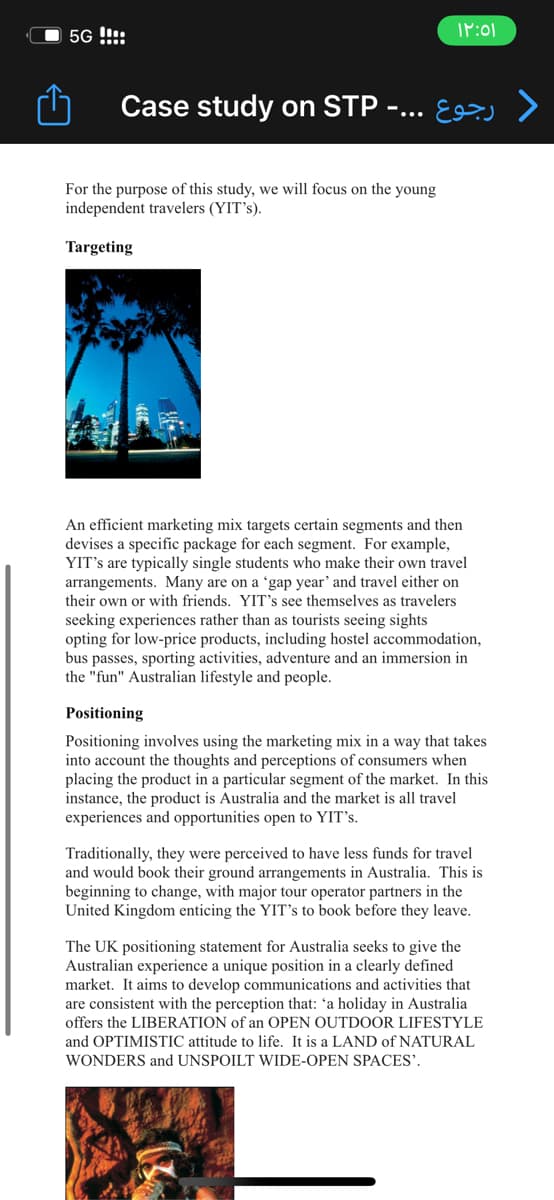What segmentation criteeria is used by atc? What targeting strategy is used by atc? What is the positioning of atc? What are the need of the target segment?
What segmentation criteeria is used by atc? What targeting strategy is used by atc? What is the positioning of atc? What are the need of the target segment?
Principles Of Marketing
17th Edition
ISBN:9780134492513
Author:Kotler, Philip, Armstrong, Gary (gary M.)
Publisher:Kotler, Philip, Armstrong, Gary (gary M.)
Chapter1: Marketing: Creating Customer Value And Engagement
Section: Chapter Questions
Problem 1.1DQ
Related questions
Question
What segmentation criteeria is used by atc ?
What targeting strategy is used by atc?
What is the positioning of atc?
What are the need of the target segment?

Transcribed Image Text:5G !!!!
Case study on STP -... >>
In recent years, Australia has become an increasingly desirable
holiday destination for UK travelers due to its diversity as a
travel destination, beaches, outback, rainforests, city lifestyle
and adventure. This is also the result of cheap flights and the
strength of the £ sterling against the Australian dollar; more than
50% of all European arrivals are from the UK. In addition the
UK is the third largest source market for visitors to Australia
behind Japan and New Zealand. This influx of visitors from
overseas has greatly benefited the Australian economy.
Market segmentation
۱۲:۵۱
It is generally recognized that marketers cannot develop
strategies that appeal to all buyers in all markets: a broad sweep
to catch all does not work. This is because buyers have different
characteristics and needs as well as different ways of going
about buying. Rather than trying to compete within an entire
market in a broad, unfocused way, organizations have to
recognize and identify those market segments that they can best
serve. To do this, they need to understand:
. the nature, attributes and appeal of their own product(s)
the buying behavior of their customers (length of stay,
money to spend on travel)
.Potential size of their market.
They must then develop sophisticated marketing strategies that
are carefully aimed at targeted groups of consumers. There are
three main phases involved in serving a distinct market:
Phase 1: SEGMENTATION
Phase 2: TARGETING
Phase 3: POSITIONING
Segmentation
ATC (Australian Tourist Commission) has maximized the
efficiency of its marketing efforts by breaking up the travel
market into specific market segments, including:
independent adventurers aged 25-34 (primary market)
young independent travelers (YIT's) aged 18-24
(secondary market)
. Independent adventurers aged 45-65.
For the purpose of this study we will focus on the young

Transcribed Image Text:5G !!!!
۱۲:۵۱
Case study on STP -... >>
For the purpose of this study, we will focus on the young
independent travelers (YIT's).
Targeting
An efficient marketing mix targets certain segments and then
devises a specific package for each segment. For example,
YIT's are typically single students who make their own travel
arrangements. Many are on a 'gap year' and travel either on
their own or with friends. YIT's see themselves as travelers
seeking experiences rather than as tourists seeing sights
opting for low-price products, including hostel accommodation,
bus passes, sporting activities, adventure and an immersion in
the "fun" Australian lifestyle and people.
Positioning
Positioning involves using the marketing mix in a way that takes
into account the thoughts and perceptions of consumers when
placing the product in a particular segment of the market. In this
instance, the product is Australia and the market is all travel
experiences and opportunities open to YIT's.
Traditionally, they were perceived to have less funds for travel
and would book their ground a rangements in Australia. This is
beginning to change, with major tour operator partners in the
United Kingdom enticing the YIT's to book before they leave.
The UK positioning statement for Australia seeks to give the
Australian experience a unique position in a clearly defined
market. It aims to develop communications and activities that
are consistent with the perception that: 'a holiday in Australia
offers the LIBERATION of an OPEN OUTDOOR LIFESTYLE
and OPTIMISTIC attitude to life. It is a LAND of NATURAL
WONDERS and UNSPOILT WIDE-OPEN SPACES'.
Expert Solution
This question has been solved!
Explore an expertly crafted, step-by-step solution for a thorough understanding of key concepts.
Step by step
Solved in 2 steps

Recommended textbooks for you

Principles Of Marketing
Marketing
ISBN:
9780134492513
Author:
Kotler, Philip, Armstrong, Gary (gary M.)
Publisher:
Pearson Higher Education,

Marketing
Marketing
ISBN:
9781259924040
Author:
Roger A. Kerin, Steven W. Hartley
Publisher:
McGraw-Hill Education

Foundations of Business (MindTap Course List)
Marketing
ISBN:
9781337386920
Author:
William M. Pride, Robert J. Hughes, Jack R. Kapoor
Publisher:
Cengage Learning

Principles Of Marketing
Marketing
ISBN:
9780134492513
Author:
Kotler, Philip, Armstrong, Gary (gary M.)
Publisher:
Pearson Higher Education,

Marketing
Marketing
ISBN:
9781259924040
Author:
Roger A. Kerin, Steven W. Hartley
Publisher:
McGraw-Hill Education

Foundations of Business (MindTap Course List)
Marketing
ISBN:
9781337386920
Author:
William M. Pride, Robert J. Hughes, Jack R. Kapoor
Publisher:
Cengage Learning

Marketing: An Introduction (13th Edition)
Marketing
ISBN:
9780134149530
Author:
Gary Armstrong, Philip Kotler
Publisher:
PEARSON


Contemporary Marketing
Marketing
ISBN:
9780357033777
Author:
Louis E. Boone, David L. Kurtz
Publisher:
Cengage Learning